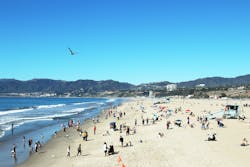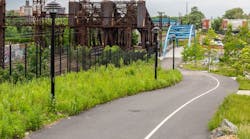Ajani Stewart is senior management consultant, Urban and Coastal Resiliency, for Arcadis. Stewart can be reached at [email protected]
undefinedThe time to protect our coasts is now. Increasingly intense storm events and flooding concerns are putting pressure on coastal communities and governments to address coastal erosion. Major storms and infrastructure breaches trigger emergency relief, but reactive repairs only go so far. It will take a proactive stance to address the interconnected needs of communities threatened by coastal erosion and design long-term resilient solutions that benefit everyone.
As sea levels and groundwater levels in many coastal communities rise, the environmental, economic and social infrastructures that define these places are more entwined than ever. Better connected communities recover quickly and effectively, while those that fail to consider every form of infrastructure inevitably weaken all of them. Early planning that accounts for these interconnected needs is critical to breaking the cycle of reactivity, improving lives and increasing equitable outcomes in increasingly vulnerable coastal communities.
A Living Coast
Coasts are always moving and changing. Controlling erosion in part depends on designing solutions that are as adaptable as the environment itself.
Levees, seawalls and jetties are perhaps the most notable and visible structures associated with coastal erosion. However, these can have unintended consequences – altered currents, longshore transport of sediment, altered migration patterns of aquatic and coastal species and more. In Staten Island, observed erosion sparked conversations about the best way to protect the local tourism industry and the oyster species that were critical to the environmental health of those beaches. The traditional default solution, jetties, had the potential to transport or move the oysters as much as coastal erosion itself, so identifying an alternative was necessary.
To determine the best option, Arcadis engineers evaluated the dominant wind directions, wave directions, currents, and sediment transport as well as the coast’s history of movement and change in light of storm events, seasonal cold fronts and more. After evaluating all the variables, the team discovered that the oysters they wanted to preserve could actually be the solution. Offshore oyster habitats could be aligned to protect the coast from dominant wave energy while still allowing for the mollusks’ growth. As sea levels rise, the oysters could adapt by growing on top of and cementing themselves to each other. This living structure then would maintain the level of wave break required to minimize erosion and preserve water quality.
More than 1,200 miles down the coast, in the Gulf of Mexico, erosion and scour are raising additional environmental concerns, especially as sea levels continue to rise. Beyond the impact on species and beaches, there is also an effort underway to evaluate the threat to oil and gas pipelines near the water. Accurate modeling, experts say, is the key to ensuring that any proposed solution helps avoid pipe rupture and, in turn, protect property, beaches and the water from oil leaks or spills. This same consideration must be applied to wastewater treatment plants, power plants and other utilities that can wreak havoc on people’s lives and local environments if compromised by coastal erosion.
The Cost of a Changing Landscape
The industries that thrive along the coast, whether for transport or supply chain purposes, have lasting economic impact on the people and environments in that area. In the case of many coastal communities, tourism is a major economic driver.
Tourism in many coastal regions would be impossible without roads and bridges. Like all other infrastructure, erosion can infringe upon bridges. When planning for bridge replacements in coastal zones, engineers and planners must account for multi-directional flows, flood tides and ebb tides, the effects of waves and hurricanes, the function of the water underneath, and also the people utilizing or affected by them. If a bridge is near a port, large industrial complexes, military installations or other facilities that depend on water for transport, the traffic underneath is as much of a factor as the traffic crossing the bridge.
Another factor is cost. Given the economic benefits of tourism, it is important to take into account the cost of building and maintaining resorts, infrastructure and the beaches themselves. Beach renourishment and sand purchasing is a multibillion-dollar industry in and of itself. In contrast, in a recently released Sea Level Rise Strategy, Miami-Dade County lists “a number of strategies for living with water," from elevating buildings onto pilings so as to allow flood waters to pass underneath — such as in the Keys — to creating “green and blue” neighborhoods that can accommodate more water in parks, yards and streets. These approaches look to find ways to accommodate expected sea level rise, and the expectation of what it means to live at sea level, as opposed to trying to combat it with heavy investment in structures alone.
The complexity of cost on the coast continues to get more elaborate when considering that the homes and resorts most likely to build on the coast are doing so at either large scale, high-value or both. Insurance, both private and FEMA, incentivizes people to build back at the same value that they might lose in a storm event. Miami-Dade’s Sea Level Rise Strategy challenges this practice by encouraging proactive investment that limits otherwise reactive, and much costlier, spending. For example:
- Every $1 invested in protecting buildings against high tides and 10-year storms with floodproofing, elevation and permeable surfaces will save $9 and create 3,000+ job years by 2040.
- Every $1 invested in community-wide measures like green infrastructure and sea walls will save $5 and create 15,000 job years by 2040.
- In Miami-Dade County, an additional $6 million investment in resilience measures could protect more than $158 million in capital projects and avoid $24 million in damage and repairs.
The Heart of the Matter
The potential savings are critical for driving investment in coastal erosion control and mitigation. However, the highest value homes and properties are often owned by individuals and companies that are more likely to be able to afford to rebuild.
Proactive planning, not just rebuilding or overbuilding after a storm event, can shift the social paradigms that exist in a region to pave the way for more equitable outcomes. Ensuring everyone in a community has increased capacity to adapt to changing conditions, such as coastal erosion, is critical to long-term results that do not just preserve but improve the vitality of a coastal community.
In many disadvantaged communities, storm preparedness and access to news, the financial ability to recover, relocate or rebuild, and even the opportunity to return to work is significantly more limited than it might be in affluent communities. For example, the repercussions of a washed out road on someone who uses that road to commute to an hourly wage job at a resort is a more qualitative measure of how coastal erosion can impact a community’s social and economic infrastructure. These qualitative measures can paint a more robust picture of what coastal erosion means for vitality and longevity in a region. When paired with the quantitative insight of localized benefit cost analysis, communities can better assess how certain proposed solutions will reverse or mitigate socioeconomic specific risks.
Factoring in social infrastructure and making recommendations that accurately reflect the needs of any given community goes beyond the structural and technical skills most often considered when developing coastal erosion control strategies. In the case of Miami-Dade County’s Sea Level Rise Strategy, ongoing community engagement was critical to incorporating strategies that accounted for everyone in the region’s priorities.
While there are significant hurdles, working closely with local advocacy groups that are well connected in the community and offering various engagement opportunities for residents can be helpful for gathering essential qualitative data.
A Better Future for Coastal Communities
The complexities associated with coastal erosion control extend far beyond any one beach or levee. Structures and numbers might be the quickest way to envision a future at sea level, but the only way to design lasting solutions that truly improve quality of life for everyone who works, lives or plays in a community is to look closely at the interconnected relationship between social, environmental and economic infrastructure. Taking a comprehensive approach that accounts for all of these factors can improve long-term resiliency from every angle and protect the coast for generations to come.






